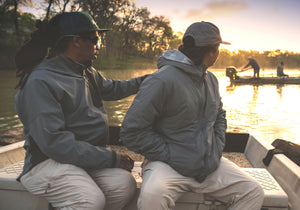Fly fishing is more than just a sport—it's a way to connect with nature and immerse yourself in the serenity of rivers, lakes, and streams. But as anglers, we have a responsibility to protect these precious ecosystems. By adopting sustainable fly fishing practices, we can ensure that our favourite spots remain pristine for generations to come. This article explores eco-friendly fishing tips and how to reduce your environmental impact.
Why Sustainable Fly Fishing Matters
Fly fishing takes place in some of the most beautiful and fragile environments on Earth. These ecosystems—from mountain streams to coastal estuaries—are vital habitats for fish, birds, and other wildlife. Unsustainable fishing practices, pollution, and habitat destruction threaten these environments. By practicing sustainable fly fishing, anglers can:
-
Protect fish populations from overharvesting.
-
Minimise pollution and waste.
-
Preserve natural habitats.
-
Ensure the sport's long-term viability.
Eco-Friendly Fishing Tips for Anglers
Here are some actionable eco-friendly fishing tips to help reduce your environmental footprint while enjoying fly fishing:
1. Use Barbless Hooks
Barbless hooks are a simple yet effective way to minimise harm to fish. They make catch-and-release fishing more sustainable by:
-
Reducing the risk of injury to fish.
-
Making it easier to release fish back into the water quickly.
-
Decreasing stress on fish populations.
Many experienced anglers find that barbless hooks also improve their skills, as proper technique becomes more important.
2. Practice Catch and Release Responsibly
Catch and release is a cornerstone of sustainable fly fishing, but it must be done carefully to ensure the fish survive. Follow these guidelines:
-
Use a rubber or soft mesh net to avoid damaging the fish’s scales and slime coat.
-
Wet your hands before handling fish to prevent the removal of protective slime.
-
Minimise the time fish spend out of the water.
-
Revive fish gently by holding them in the water until they swim away on their own.
3. Choose Eco-Friendly Gear
Sustainable fly fishing starts with the right gear. Look for products made from recycled, biodegradable, or sustainable materials:
4. Dispose of Waste Responsibly
Fishing-related litter, such as discarded line, can pose serious threats to wildlife. Always:
-
Pack out everything you pack in.
-
Use a line recycling system to dispose of old tippet and leaders.
-
Keep a small bag for litter you find while fishing and dispose of it properly.
5. Respect Seasonal Restrictions and Local Regulations
Regulations exist to protect fish during vulnerable times, such as spawning seasons. Always:
-
Check local fishing laws before heading out.
-
Follow seasonal closures and size or bag limits.
-
Avoid disturbing spawning grounds.
6. Be Mindful of Invasive Species
Invasive species can devastate native ecosystems. To prevent their spread:
-
Clean, drain, and dry your gear after each trip.
-
Avoid transporting water, plants, or animals between fishing locations.
-
Learn to identify invasive species and report sightings to local authorities.
7. Support Conservation Initiatives
Many organisations work tirelessly to protect aquatic ecosystems. You can support their efforts by:
-
Donating to conservation groups.
-
Participating in clean-up events.
-
Advocating for policies that protect natural habitats.
Sustainable Practices for Fly Tying Enthusiasts
Fly tying is a cherished aspect of the sport, allowing anglers to tie their own flies. However, it’s important to consider sustainability when sourcing materials:
-
Use natural, ethically sourced feathers and fur.
-
Repurpose old materials from other flies.
-
Opt for synthetic materials made from recycled plastics.
By tying your flies responsibly, you can reduce waste and make your fly fishing more sustainable.
The Role of Education in Sustainable Fly Fishing
Education is a powerful tool in the fight for sustainability. Share your knowledge and passion for eco-friendly fly fishing with others. Encourage fellow anglers to:
-
Adopt sustainable practices.
-
Learn about the ecosystems they fish in.
-
Respect wildlife and their habitats.
Mentoring new anglers is also an opportunity to instill sustainable habits from the start.
The Future of Sustainable Fly Fishing
The future of fly fishing depends on our commitment to protecting the environment. Innovations in eco-friendly gear and techniques continue to make sustainable fly fishing more accessible. Brands like Orvis are leading the way, offering products and resources that prioritise conservation.
Getting Involved in Habitat Restoration
Habitat restoration plays a critical role in sustaining healthy fish populations and ecosystems. As an angler, you can actively participate in restoration efforts to ensure the long-term viability of fly fishing. Here’s how you can contribute:
-
Join local initiatives focused on restoring rivers, streams, and wetlands.
-
Volunteer for tree planting projects along riverbanks to prevent erosion and improve water quality.
-
Support organisations working to remove barriers and obstructions that hinder fish migration.
-
Educate yourself about the challenges facing aquatic habitats and advocate for solutions.
By taking part in habitat restoration, you’re not only helping fish populations thrive but also ensuring the overall health of the ecosystems that make fly fishing possible.
Final Thoughts
Fly fishing is a deeply rewarding activity that fosters a connection with nature. By adopting sustainable fly fishing practices and following eco-friendly fishing tips, anglers can ensure that these experiences remain available for future generations. Whether it’s through responsible catch and release, choosing eco-conscious gear, or supporting conservation efforts, every small action makes a difference.
So, next time you head out to cast your line, remember the importance of sustainability. Together, we can protect the waters we love and the incredible ecosystems that call them home.

